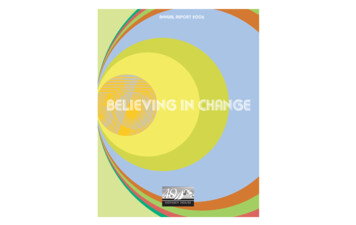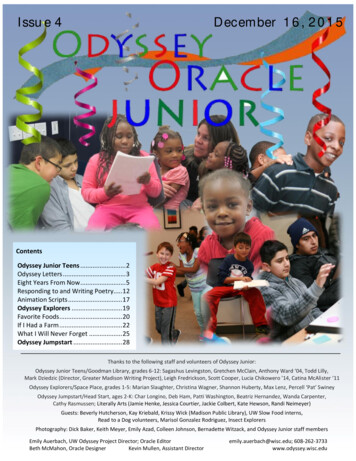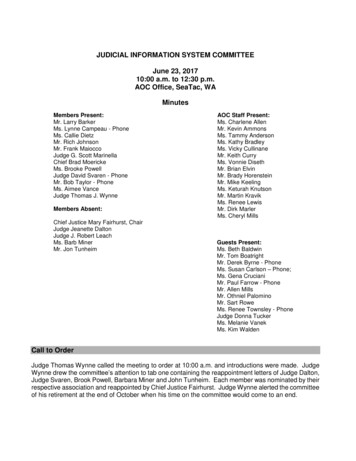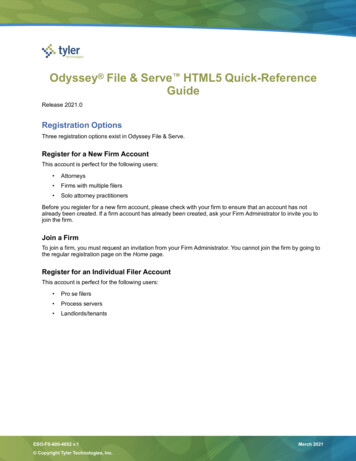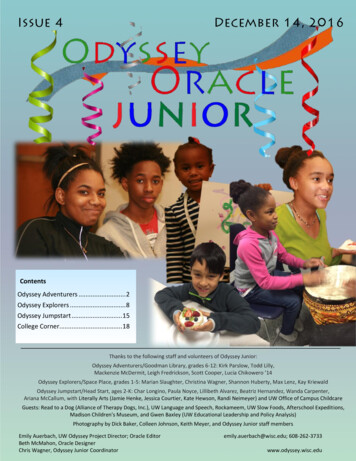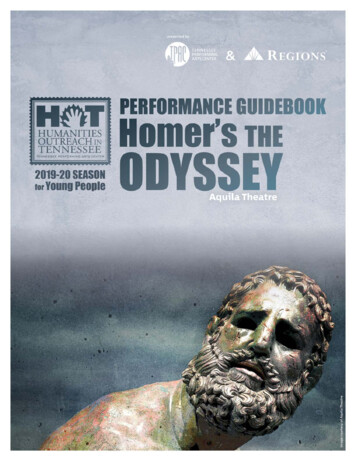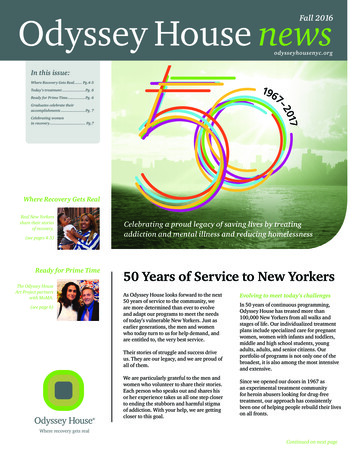
Transcription
Odyssey House newsFall 2016odysseyhousenyc.orgIn this issue:Where Recovery Gets Real. Pg.4-5Today’s treatment.Pg. 6Ready for Prime Time.Pg. 6Graduates celebrate theiraccomplishments.Pg. 7Celebrating womenin recovery. Pg.7Where Recovery Gets RealReal New Yorkersshare their storiesof recovery.(see pages 4-5)Ready for Prime TimeThe Odyssey HouseArt Project partnerswith MoMA.(see page 6)Celebrating a proud legacy of saving lives by treatingaddiction and mental illness and reducing homelessness50 Years of Service to New YorkersAs Odyssey House looks forward to the next50 years of service to the community, weare more determined than ever to evolveand adapt our programs to meet the needsof today’s vulnerable New Yorkers. Just asearlier generations, the men and womenwho today turn to us for help demand, andare entitled to, the very best service.Their stories of struggle and success driveus. They are our legacy, and we are proud ofall of them.We are particularly grateful to the men andwomen who volunteer to share their stories.Each person who speaks out and shares hisor her experience takes us all one step closerto ending the stubborn and harmful stigmaof addiction. With your help, we are gettingcloser to this goal.Evolving to meet today’s challengesIn 50 years of continuous programming,Odyssey House has treated more than100,000 New Yorkers from all walks andstages of life. Our individualized treatmentplans include specialized care for pregnantwomen, women with infants and toddlers,middle and high school students, youngadults, adults, and senior citizens. Ourportfolio of programs is not only one of thebroadest, it is also among the most intensiveand extensive.Since we opened our doors in 1967 asan experimental treatment communityfor heroin abusers looking for drug-freetreatment, our approach has consistentlybeen one of helping people rebuild their liveson all fronts.Where recovery gets realContinued on next page
Continued from page 1It is an approach that is needed just asmuch today as we continue to grapplewith substance abuse problems, mentalillness, and homelessness.In commemoration of our 50th anniversary, each monthwe have been sharing a story that highlights one of ourprograms or treatment populations. Here are the storiesfrom the first quarter of our year-long celebration.Learning from the pastIn the 1960s, the country was in the gripof a heroin epidemic that was layingwaste to the lives of thousands of youngpeople. From 1963 to 1974, 300,000New York City residents were eitherknown or suspected addicts, 95% ofthem for heroin abuse.Today, opioid abuse, primarilyprescription pain relievers and heroin,is again devastating communities. Thelatest national data from the Centers forDisease Control and Prevention (CDC)reports as many as 80 Americans a day(or 29,200 a year) dying from opioidoverdoses. Of these deaths, 2,002 areNew Yorkers.While the numbers of preventabledeaths from opioid misuse aredistressing, experts believe they wouldbe even higher if it weren’t for theadvancements made in the treatmentand prevention of substance misuse andmental health disorders.Many of these advances are the resultof treatment organizations on the frontlines responding swiftly to the needsof their communities with peer-driven,residential and outpatient programs.At Odyssey House, we have expandedour programs to reflect the needsof families, youth, and older adultswith flexible options that can includemedication-assisted treatment (MAT)alongside behavioral health therapies.This holistic model has been replicatedthroughout the country and overseasand is now regarded as the goldstandard for treatment of substancemisuse and mental health disorders.Along the way, this flexible treatmentmodel that integrates peer-driven, selfhelp therapies with medical, psychiatric,educational, and vocational services, hassaved thousands of lives.“Every minute I spent at Odyssey House was worth it.”Ashley, 28, started using drugs and alcohol aftergraduating high school in Long Island. It started withthe occasional use of marijuana and alcohol, mostly as ameans of fitting in with her friends and dealing with lowself-esteem. It also made it easier to ignore that she wasdirectionless, in and out of college, unable to decide whatto study or do with her life.Her drug use developed into a full-fledged problem whenshe was 23. By then she was a new mother. To managethe trauma of escaping an abusive relationship with herdaughter’s father and the stress of single parenthoodAshley, turned to cocaine, marijuana, and alcohol.Ashley was admitted to the young adult women’s program in the Bronx last October.It took time, but once she adjusted to the structured environment, she began to feelherself change. Being in treatment “helped me open up to others, understand that theway I was living was wrong, and bridge the gap between me and my family,” she says.The groups were particularly beneficial in helping Ashley find peace. “The more I talkedto my peers, the lighter my burden felt.”Taking the first step to putting her family back togetherWhen Joi entered the Manor Family Centerin August 2015, she was lost. Struggling withdepression, low self-esteem, and alcoholism,she needed a “new beginning” – an opportunityto turn her life around and regain custody ofher children.The 31-year-old mother of four hadexperienced a number of difficulties, includingdomestic violence and homelessness, but ittook the Administration for Children’s Services(ACS) removing custody of her baby tounderscore the urgency of her situation.Though ACS recommended an outpatient program, Joi chose residential treatment.While in Odyssey House, Joi regained custody of her youngest child in only fourmonths, and with the support of their grandfather, repaired her relationship withher older children. Joi also successfully completed vocational training and earned asecurity guard license.Joi completed treatment in early May and is continuing to work on her recovery atour Outpatient Services in the Bronx. With help from her counselors, she found anapartment to move into after treatment and now lives with her youngest child, withregular visits from her older children.2Odyssey House News, Fall Issue 2016
“I can find joy in life again.”Art has been a part ofKenneth’s life for more than40 years. Growing up, thecomfort of creation helpeddistract Kenneth, 55, fromthe stresses of growing upin the projects with a singlemom raising him and hissiblings. As Kenneth reachedhis teenage years, art gaveway to drugs and alcohol as ameans of escape. For the nexttwenty-five years, Kennethstruggled with his addiction to cocaine and alcohol and foundhimself in and out of treatment programs.A few years ago, Kenneth became homeless after he lost his job, andhe had no money to pay his rent. Feeling hopeless about his future,Kenneth isolated himself. He relapsed, and knowing he needed tomake a change, he entered residential treatment at Odyssey House.In treatment, Kenneth found sanctuary by participating in workshopsat the Odyssey House expressive arts studio. Kenneth says creatingart allows him to express himself in ways he cannot verbally, andsupports his recovery in a safe and sober environment. “The OdysseyHouse Art Project helped me find myself. I can find joy in life again.”This July, Kenneth celebrated one year of sobriety, giving him a morehopeful outlook on his life: “Now that I’ve reached this milestone, it’sgoing to be a brighter future for me.”“Focus and persistence is a powerful tool”From a very young age, Chane,29, let his opioid addiction dictatehis actions, leading to expulsionfrom high school and involvementin the judicial system. After beingarrested for stealing to fund his drughabit, he was offered treatment atOdyssey House as an alternative toincarceration. Seeing an opportunity,Chane knew it was time to takecontrol of his future.While in treatment at the LeadershipCenter, he dedicated himself tofinishing his high school education and passing the TASC. Chanewas nervous about how he would do, as he hadn’t been in aclassroom in more than 10 years and had always struggled withmath. Discussing his concerns with his vocational counselor gaveChane the confidence he needed to succeed as long as he workedhard and applied himself.The breakthrough came from his math teacher. Chane says, “Myteacher’s unique way of looking at math problems made problemsthat looked difficult become really simple.”Save the date! Run for Your Life 5KSaturday, September 24, 2016Join the voices for recovery* Children’s races Fitness demos Prizes Recovery Walk Zumba RefreshmentsRegistration & details @odysseyhousenyc.org*A National Recovery Month EventChane not only passed the TASC but received the second highestscore among his peers.3
odysseyhousenyc.orgGetting real. It’s more than a taglineLast year, we embarked on a challenge: how to fully articulatewhat we stand for – the compelling, focused idea that sets usapart and puts our clients at the heart of our identity. Throughextensive research, and interviews with our staff and clients, wefound it: getting real.What does that mean – to get real about recovery? Getting real means understanding the uniqueproblems of New Yorkers because we’re NewYorkers, too. Getting real means providing integrated,personalized treatment plans that address all ofour clients’ needs— their physical and mentalhealth, home and family, and job and education. Getting real means providing our client with asupport network of people who understand theirchallenges—for life.This project informed our new tagline and culminatedin the creation of a fresh, new website that reflectswhat it means to get real about recovery, and how wehelp our clients do just that, so they can live healthy,happy, and substance-free lives. Visit the new website atodysseyhousenyc.org and let us know what you think.4Odyssey House News, Fall Issue 2016Our aim with this new site is topresent Odyssey House through theexperiences, hopes, and achievementsof our clients. We talked to clientsfrom every program, listened carefullyto what they had to say, and wovetheir stories into a narrative thatpresents Odyssey House as anorganization that offers hope andopportunity to all New Yorkers.new features: Integrated social media buttons forFacebook, Twitter, and more An improved News section with helpfulinformation, articles, newsletters, andevents that will be updated regularly New recovery stories from residents ofour treatment and housing programs (seeopposite page) Two ways to contact our Admissionsdepartment: through an online form anda toll-free number, 866-888-7880
real recovery storiesEvery day, New Yorkers come toOdyssey House for help—and the results are life-changing.Here are excerpts of some of their stories.Angel: Spanish HarlemAmanda: Long IslandHeaven: HarlemNow I understand I haveto stay focused on myrecovery every day.I’ve already noticedhow my behavior andattitude have changedfor the better.My kids need me to bethe best I can be, sothat they can be thebest they can be.Shavar: HarlemJean: BronxAaron: Long IslandIt’s a peaceful environmentthat gives me a placeto focus on my recoveryand stay healthy.I'm more focusedon schoolwork andresponsible for myactions now.I never want to disappointmyself or my family again,so I’m making each dayin treatment count.Visit odysseyhousenyc.org to read the full-length stories from Heaven, Angel, Amanda, and many more.5
Ready for Prime TimeMembers of the Odyssey House Art Project went back to school earlier this year tostudy contemporary art at one of New York City’s premier museums. In a specialpartnership between the Museum of Modern Art (MoMA) and Odyssey House, clientsin treatment at the ElderCare program participated in a new initiative that connectsolder New Yorkers with modern and contemporary art; a project MoMA says aimsto “rethink how museums and cultural institutions can support a fulfilling agingprocess—one defined by creativity, curiosity, connectedness, and continued growth.”Over a six-week period, students were treated to in-depth guided tours of themuseum’s exhibits and given the opportunity to try out some of the artistic techniquesthey’d studied at hands-on workshops at MoMA’s education center, and also back atthe Odyssey House studio.But the special treatment didn’t end there. At the completion of the course, the artistswere invited to a reception at MoMA and their artwork was proudly displayed as partof the museum’s Prime Time series.Today’sTreatment:Combining behavioral therapyand medication assistanceMedication-assisted treatment (MAT) ispharmacotherapy used to support treatmentand recovery efforts for people seeking toovercome addictive disorders. It combinesprescribed medications with counseling andbehavioral therapies, monitoring, communitybased services, and recovery supports. MAT isdesigned to assist, not replace, other treatmentand recovery efforts and supplementspsychological, behavioral, and socialinterventions. At Odyssey House we currentlyoffer the following medication assistance:Naltrexone (Revia, Vivitrol) is an opioidantagonist that is non-addictive or sedating,does not result in physical dependence,and has no potential for abuse. Naltrexonecan be taken orally (Revia) or through anextended release formulation (Vivitrol) that isdelivered in a monthly injection. Naltrexonecan only be used after a client has undergonedetoxification.We also offer both the oral and injectableforms of naltrexone to clients diagnosed witha history of an alcohol use disorder. Althoughit is not fully understood as to why an opioidantagonist works in treating alcoholism,it is believed that naltrexone blocks thepleasurable effects of alcohol by blocking therelease of endorphins.“What Makes a Family,” a group project by members of the ElderCare Program ondisplay at the Prime Time show.Odyssey House ElderCare participant,Robert C., spoke at the reception abouthow studying at the museum had openedhis eyes to modern art and helped himunderstand the powerful role creativitycan play in his recovery. He is seen herewith Odyssey House Geriatric CounselorTemmi Merlis.6Odyssey House News, Fall Issue 2016Jerald Frampton, director of OdysseyHouse Art Project, with MoMA educatorsSally Paul (right) and Laurel Humble.Acamprosate (Campral) is used along withcounseling and social support to help peoplewho have stopped drinking large amountsof alcohol to avoid drinking alcohol again.Drinking alcohol for a long time changes theway the brain works. Acamprosate works byhelping the brains of people who have drunklarge amounts of alcohol to work normallyagain, but does not prevent the withdrawalsymptoms that people may experience whenthey stop drinking alcohol. Acamprosate hasnot been shown to work in people who havenot stopped drinking alcohol or in peoplewho drink large amounts of alcohol and alsooveruse or abuse other substances such asstreet drugs or prescription drugs.Disulfiram (Antabuse) is an alcohol-abuseaversion therapy used to treat alcohol usedisorders. Disulfiram works by blocking thebreakdown of alcohol, causing unpleasantside effects (e.g., headache, nausea, vomiting)when even a small amount of alcohol isconsumed.
Graduates Celebrate Their AccomplishmentsLooking ahead to the futureTASC graduation day is a special day atOdyssey House. It’s an opportunity for ourclients to celebrate their accomplishmentsand share their future plans with their peersand families. This year, more than 40 clientspassed the TASC.For this year’s keynote speaker, SunitaManjrekar, the ceremony was a homecomingof sorts. Now the director of employmentprograms for the Nassau County Departmentof Social Services, Ms. Manjrekar wasonce the director of vocational services atOdyssey House and had a significant hand indeveloping the department as it exists today.Sunita Manjrekar (front, red shirt), who helped establish our vocational department years ago,encouraged the TASC graduates to continue their education and pursue new opportunities.“I was like a fish out of water,” laughs Mavies,thinking back to her first day of adult basiceducation (ABE) classes. After leaving schoolmore than three decades years ago, theprospect of learning math, science, and moreat her age was daunting. But she persevered,and passed the Test Assessing SecondaryCompletion (TASC), earning her high schoolequivalency diploma.After spending several years drifting fromone place to another, with no sense ofdirection or ambition, Mavies, 53, came toOdyssey House to deal with her addiction.When a counselor suggested she enroll inABE classes, she was hesitant but decidedto give it a try. Focused and determined,Mavies worked hard to attend every class,engage with the instructors, and study forthe test. She failed the first three timesshe took the exam. Rather than becomediscouraged, Mavies worked even harder,a lesson she imparted to her peers in hergraduation speech: “You only fail when yougive up. If you try once and fail, just keeptrying until you make it.”Pleased to see so many clients pursuingtheir education, Ms. Manjrekar encouragedthem to keep going. “I challenge you: don’tstop here,” she said. “This is just the veryfirst step. There are many opportunities stillwaiting for you. Never stop learning.”At least one graduate is planning onlistening to that advice. Jason, 38, addressedthe graduates as the class valedictorian.“The only thing that can hold us back nowis ourselves. So let’s not see this as the endof our academic goals but the beginning,”he said. “I’ve never thought of college as anoption for me. Now it’s not whether I’llattend college, but rather what I’ll studywhen I get there.”Celebrating Women in RecoveryEvery year, Odyssey House commemoratesWomen’s History Month with eventsthat are aimed at boosting confidenceand encouraging female bonding. It’s animportant event here as the women in ourprograms face a number of challengescoming into treatment, including copingwith low self-esteem and a history ofdomestic violence or sexual abuse. Thisyear, the Manor Family Center celebratedthe achievements of women in recoverywith a special event for staff, residents andtheir families.Janice Slaughter, VP, director of MentalHealth & Housing Services (right), embracesa resident after an emotional poetry reading.The program included musicalperformances and readings from residents,and an inspirational address from AnnetteGordon-Reed, a Pulitzer Prize-winninghistorian and law professor. The songs andreadings selected by our residents held deepmeaning for them. Belinda sang WhitneyHouston’s “Greatest Love of All” in a movingperformance. She said that song resonatedwith her, because “learning to love myselfhas been something I’ve really had to workon in treatment. My addiction destroyedmy sense of worth, and Odyssey House hashelped me build it back up.”Ms. Gordon-Reed spoke about the historyof female oppression and the importance ofuniting to overcome it. “We can’t succeedindividually, we must work together– especially if we come from any kindof disadvantage, be it gender, race, oreconomic,” she said. But it was her partingwords that best captured the attention of thewomen in the room: “Learn from everythingthat happens in your life – we have to beready and open to it. Sometimes the thingyou think is the worst thing to ever happento you, turns out to be a blessing.”7
Where recovery gets real120 Wall StreetNew York, NY 10005odysseyhousenyc.org212-361-1600On the HorizonSave the date!TCS New York City MarathonNovember 6, 2016Cheer on our marathon teamat the Mile 19 water station!Located on 1st Ave between115th & 116th Streets.Help us spread the wordfacebook.com/OdysseyHouseIt is the mission of Odyssey House:To provide comprehensive and innovative services to the broadest range ofmetro New York’s population who: A buse drugs A buse alcohol S uffer from mental illnessTo provide high quality, holistic treatment impacting all major life spheres:psychological, physical, social, family, educational and spiritual.To support personal rehabilitation, renewal and family restoration.Follow us at@OdysseyHouseNYIn all of its activities, Odyssey House undertakes to act as a responsibleemployer and member of the community, and manage the assets of theorganization in a professional manner.
way I was living was wrong, and bridge the gap between me and my family," she says. The groups were particularly beneficial in helping Ashley find peace. "The more I talked to my peers, the lighter my burden felt." When Joi entered the Manor Family Center in August 2015, she was lost. Struggling with depression, low self-esteem, and .
